G4 – Severe or greater geomagnetic storm forecast as multiple CMEs merge and impact Earth on May 11
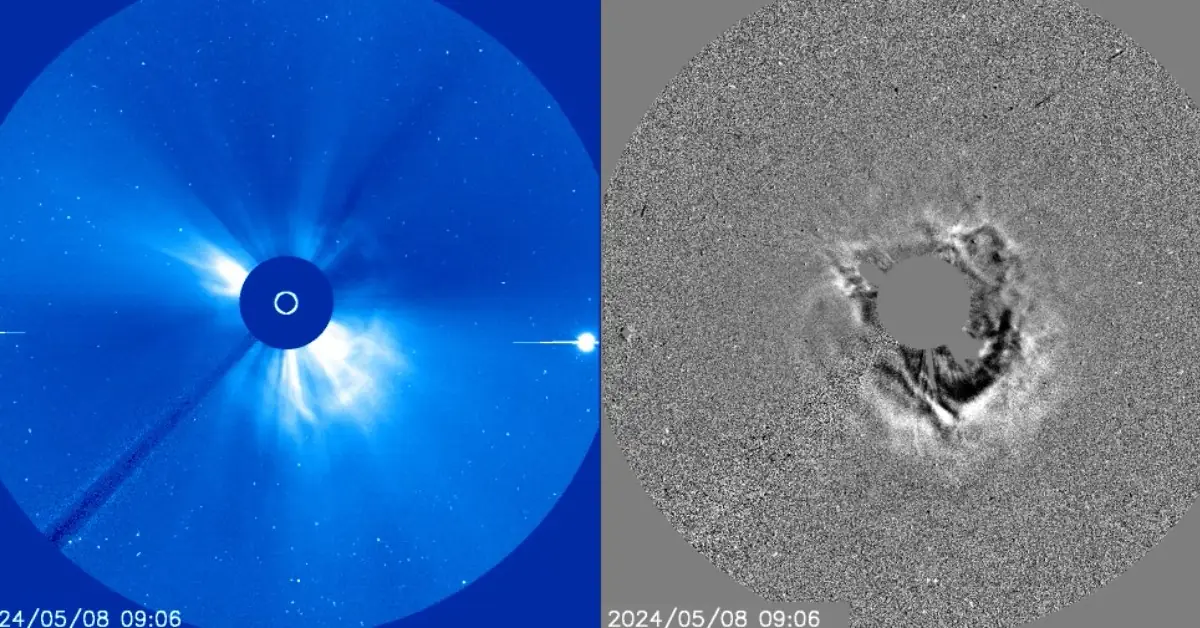
Multiple coronal mass ejections (CMEs) — of which at least 4 halo CMEs produced by Active Region 3664 over the past few days — will hit Earth, starting late May 10 into May 11, 2024. As a result, a G4 – Severe or greater geomagnetic storm watch is in effect.
- Only three G4 – Severe geomagnetic storms have been observed during this solar cycle (SC25) which began in December 2019.
- The last G4 – Severe storm was on March 23, 2024, and the last G5 – Extreme was the Halloween Storm in October 2003. That G5 resulted in power outages in Sweden and damaged power transformers in South Africa.
A G4 – Severe or greater geomagnetic storm is expected on May 11, with effects potentially extending into May 12 and 13. The storm is anticipated to impact regions primarily poleward of 45 degrees Geomagnetic Latitude. It could lead to widespread voltage control issues, with some protective systems potentially tripping key assets from the power grid due to mistakenly identified faults. Pipeline currents are also expected to intensify.
Spacecraft systems may face surface charging, heightened drag on low-earth orbit satellites, and potential tracking and orientation challenges. Satellite navigation (GPS) systems may experience significant degradation or become inoperable for hours. High-frequency (HF) radio communication could face sporadic propagation or complete blackouts. The aurora borealis might be visible as far south as Alabama and northern California.
G4 is the second-highest geomagnetic storm classification on NOAA’s scale, occurring approximately 100 times per solar cycle, which spans 11 years. The only classification above G4 is G5 – Extreme, which occurs around four times per cycle.
A G5 – Extreme geomagnetic storm can have widespread and significant impacts across various systems. In power systems, these storms can lead to voltage control issues and malfunctions in protective systems, potentially causing entire grids to collapse or experience blackouts. Transformers can also suffer damage due to increased electrical stress.
Spacecraft operations may face severe surface charging, which can interfere with orientation. Uplink and downlink signals, as well as satellite tracking, can be disrupted, hindering communication and data transmission.
In other systems, pipeline currents can surge to hundreds of amps, causing potential damage to pipeline infrastructure. High-frequency (HF) radio propagation may become impossible in many areas for up to two days, and satellite navigation could be degraded for several days. Low-frequency radio navigation may also be unavailable for hours. The aurora can appear as far south as Florida and southern Texas, around 40° geomagnetic latitude, during these storms.
Enhancements in the solar wind environment are likely to start today, May 9, following the anticipated glancing effects of a CME that departed the Sun on May 6.
Then, late on May 10 and into May 11, stronger enhancements are likely as the three CMEs that departed the Sun on May 8 and 9 are anticipated to merge into one and impact Earth.
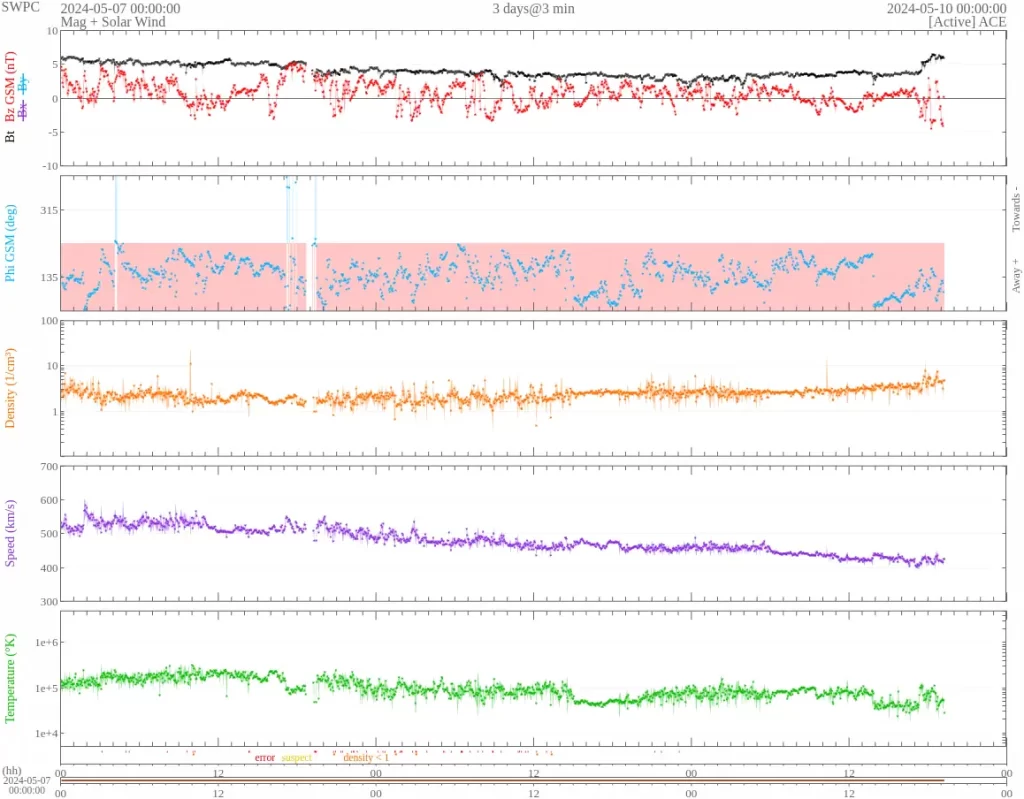
“A new NOAA forecast model suggests that three of them could merge to form a potent Cannibal CME,” said Dr. Tony Phillips of SpaceWeather.com.
“Cannibal CMEs form when fast-moving CMEs overtake slower CMEs in front of them, Phillips explains. “Internal shock waves created by such CME collisions do a good job sparking geomagnetic storms when they strike Earth’s magnetic field.”
Solar researchers believe cannibal CMEs may be the source of ‘complex ejecta’ CME clouds; those with a larger and more complex structure than typical CMEs. These traits cause complex ejecta CMEs to trigger protracted magnetic storms when they envelop the Earth, according to NOAA.
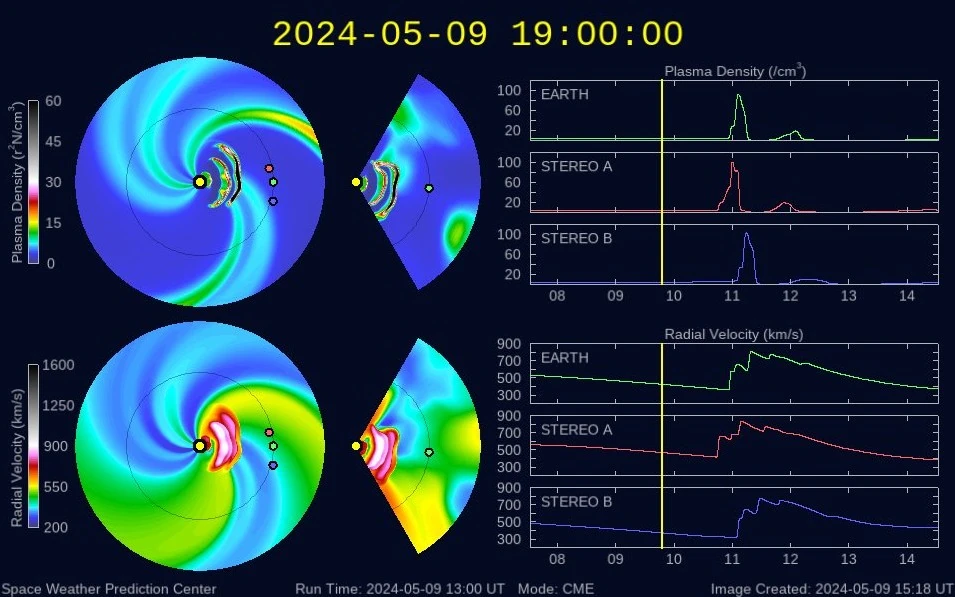
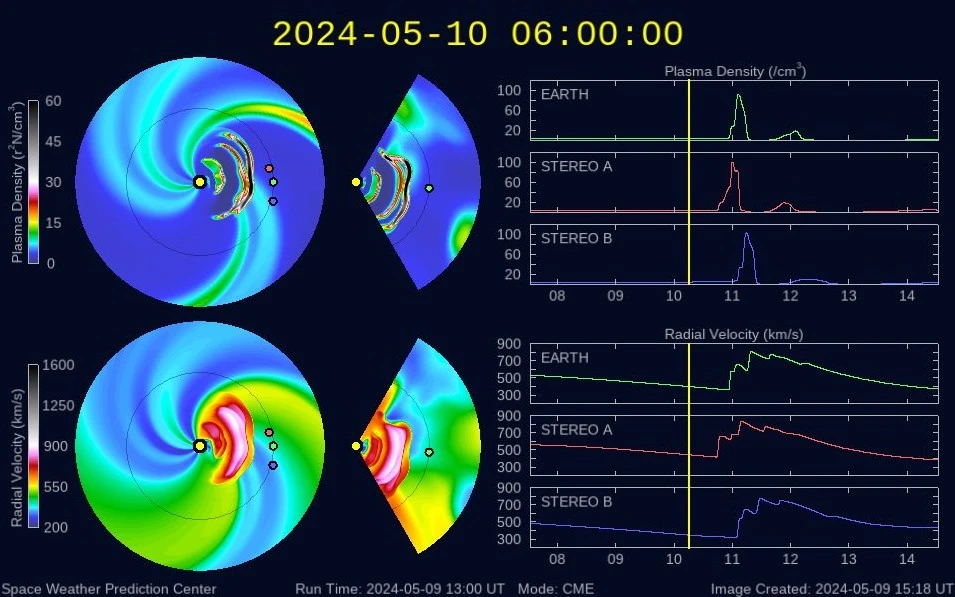
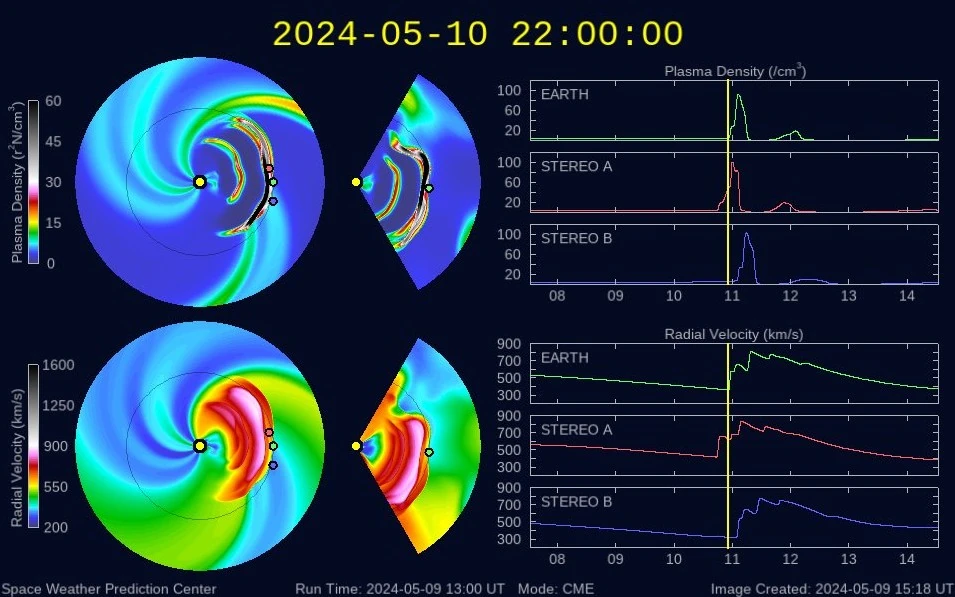
This impact will be followed by a CME produced by an approximately 35° long filament that erupted on May 8. Analysis and modeling of this event determined a possible Earth-directed component with similar timing to the halo CMEs mentioned above.
The fourth halo CME was produced during today’s X2.2 solar flare at 09:13 UTC. This one will also impact Earth in 2 to 3 days, adding to the already severely disturbed conditions.
However, that’s not the end as another X-class solar flare, this time measuring X1.1 erupted from AR 3664 at 17:44 UTC on May 9. Type IV and II radio emissions were associated with this event, suggesting a strong CME was produced. Due to the location of the responsible region, there is a good possibility this CME is also heading toward Earth.
Combine all that together, and you get extremely busy solar activity resulting in severe geomagnetic storming over the next couple of days. This sequence of events will be analyzed for a long time and surely enter history books.
Region 3664 has a ‘beta-gamma-delta’ magnetic configuration and is capable of producing more powerful solar storms and CMEs in the days ahead. While it has moved from the center of the disk it still has the potential to send more CMEs toward us.
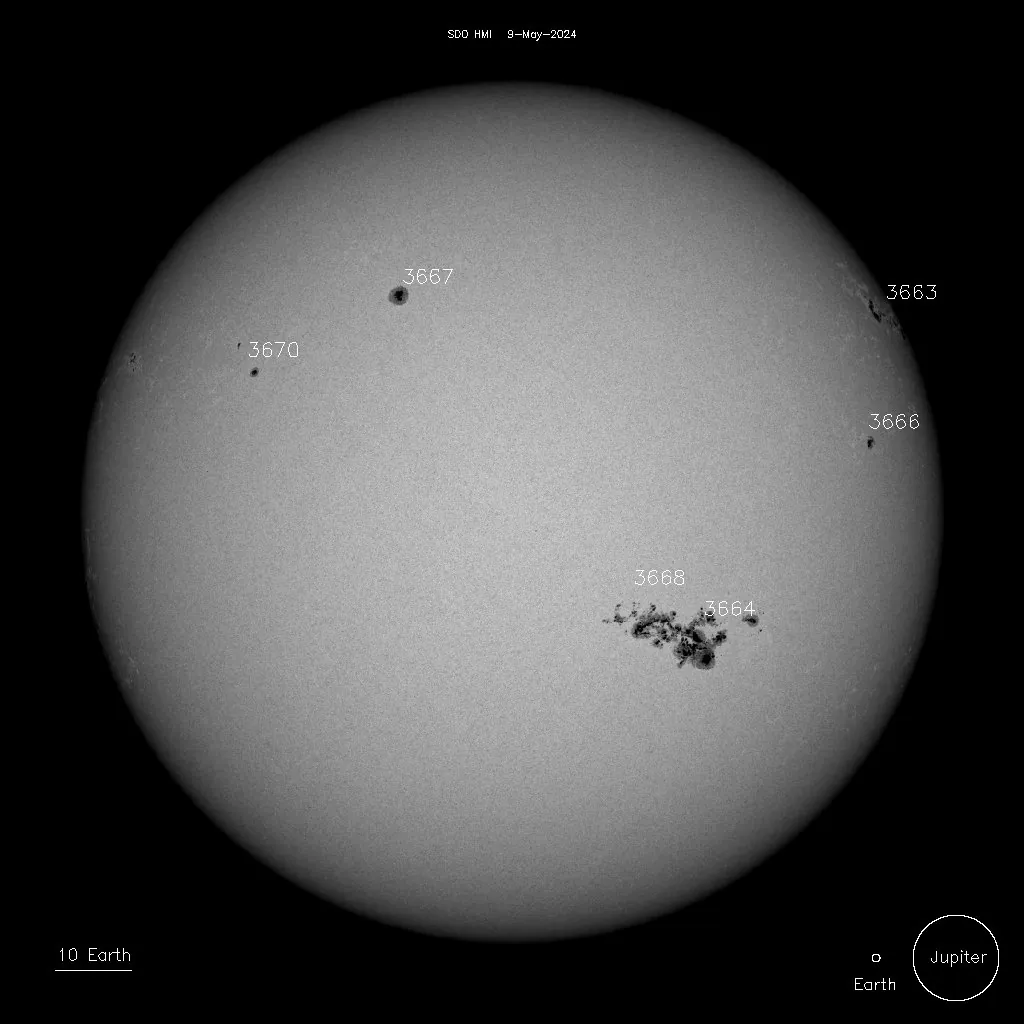
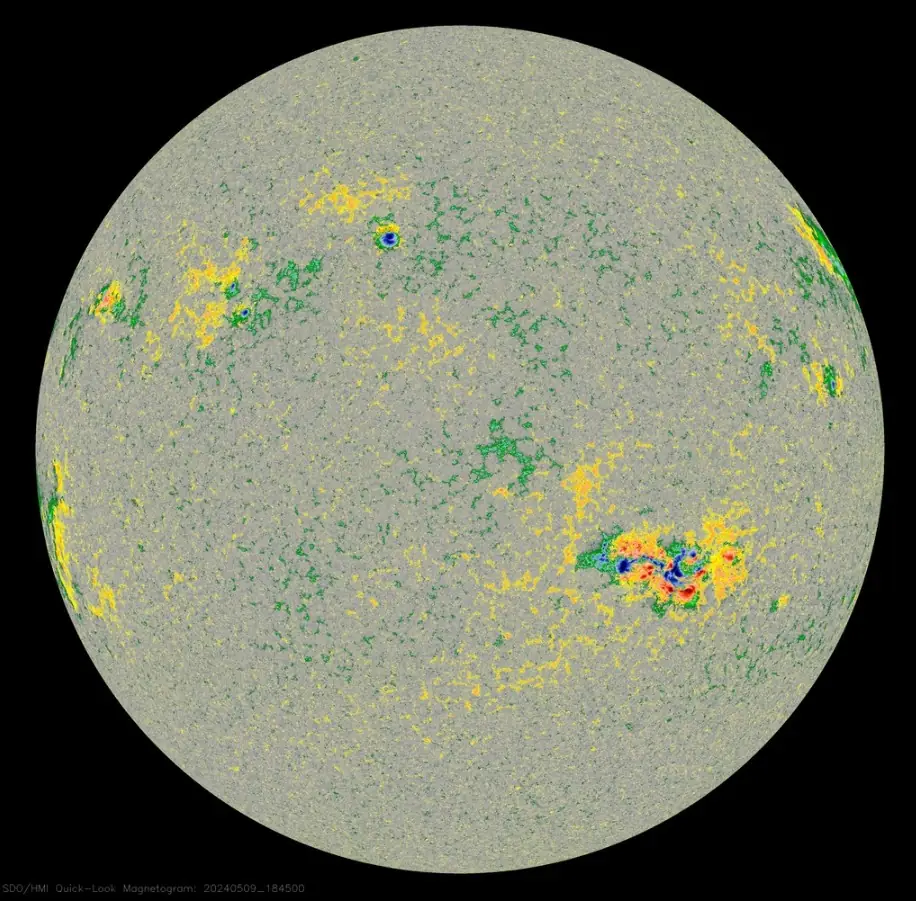
The Sun has been extremely active since the beginning of the month, producing 67 M-class flares — some of them very close to X-class, and 9 X-class flares —the strongest of which was X4.5 on May 6.
| Max class | Time (UTC) |
|---|---|
| X1.1 | 05/9, 17:44 |
| M3.7 | 05/9, 13:23 |
| M2.9 | 05/9, 12:12 |
| M3.1 | 05/9, 11:56 |
| X2.2 | 05/9, 09:13 |
| M2.1 | 05/9, 08:40 |
| M2.4 | 05/9, 06:27 |
| M2.3 | 05/9, 06:13 |
| M1.7 | 05/9, 04:49 |
| M4.5 | 05/9, 03:32 |
| M4.0 | 05/9, 03:17 |
| X1.0 | 05/8, 21:40 |
| M1.7 | 05/8, 20:34 |
| M2.0 | 05/8, 19:21 |
| M2.9 | 05/8, 18:36 |
| M7.9 | 05/8, 17:53 |
| M8.6 | 05/8, 12:04 |
| M4.1 | 05/8, 11:22 |
| M2.1 | 05/8, 09:48 |
| M1.8 | 05/8, 09:37 |
| M4.5 | 05/8, 07:41 |
| M7.1 | 05/8, 06:53 |
| X1.0 | 05/8, 05:09 |
| M3.5 | 05/8, 04:30 |
| M1.9 | 05/8, 03:42 |
| M1.8 | 05/8, 03:27 |
| M3.4 | 05/8, 02:27 |
| X1.0 | 05/8, 01:41 |
| M8.2 | 05/7, 16:30 |
| M1.0 | 05/7, 13:35 |
| M1.0 | 05/7, 13:25 |
| M1.5 | 05/7, 12:54 |
| M2.4 | 05/7, 11:50 |
| M1.3 | 05/7, 08:23 |
| M5.1 | 05/7, 06:16 |
| M2.6 | 05/7, 00:58 |
| M4.3 | 05/6, 22:27 |
| M1.2 | 05/6, 21:48 |
| M1.5 | 05/6, 09:59 |
| X4.5 | 05/6, 06:35 |
| M1.3 | 05/6, 05:28 |
| M1.6 | 05/6, 01:06 |
| M1.3 | 05/5, 19:52 |
| M1.0 | 05/5, 18:40 |
| M1.3 | 05/5, 17:01 |
| M2.2 | 05/5, 15:38 |
| M1.3 | 05/5, 14:47 |
| X1.2 | 05/5, 11:54 |
| M7.4 | 05/5, 10:00 |
| M2.3 | 05/5, 09:38 |
| M1.3 | 05/5, 08:19 |
| X1.3 | 05/5, 06:01 |
| M8.4 | 05/5, 01:27 |
| M9.0 | 05/4, 23:48 |
| M3.2 | 05/4, 22:37 |
| M1.3 | 05/4, 18:20 |
| M1.5 | 05/4, 07:07 |
| M9.1 | 05/4, 06:19 |
| M1.6 | 05/4, 00:36 |
| M2.4 | 05/3, 23:30 |
| M1.0 | 05/3, 23:16 |
| M1.2 | 05/3, 22:47 |
| M4.4 | 05/3, 08:11 |
| X1.6 | 05/3, 02:22 |
| M2.7 | 05/3, 00:15 |
| M2.7 | 05/2, 20:57 |
| M1.0 | 05/2, 02:17 |
| M1.8 | 05/1, 22:31 |
| M1.9 | 05/1, 14:44 |
| M1.8 | 05/1, 14:32 |
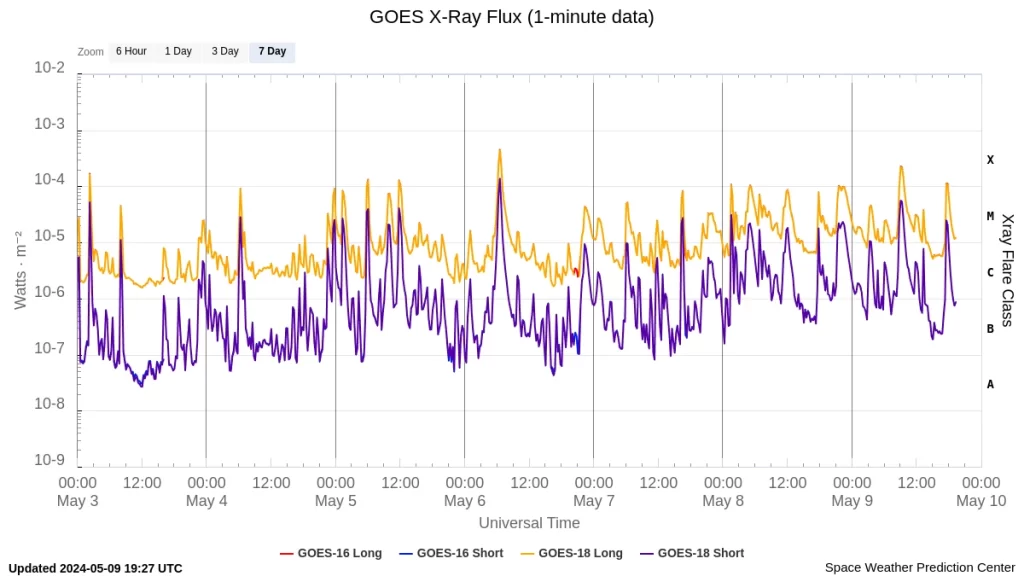
Solar activity is expected to persist at high to very high levels through May 11, with M-class flares (95%) expected and X-class flares (60%) likely, due to the continued flare potential of Region 3663 and especially Region 3664 (beta-gamma-delta).
You can follow space weather in near-real-time at SWX and follow us on X where we post all C+ solar flares and SWPC Alerts, Watches and Warnings.
Updates
07:24 UTC, May 10
A powerful solar flare measuring X3.9 erupted from Active Region 3664 at 06:54 UTC on May 10, 2024. The event started at 06:27 and ended at 07:06 UTC.
This is the 10th X-class solar flare since May 3.
We now have 4 halo CMEs heading our way (+2 more very likely — produced on May 9 and 10).
A G4 – Severe or greater geomagnetic storm watch remains in effect.
18:43 UTC, May 10
The first CME impacted Earth at 16:56 UTC on May 10. The geomagnetic field responded with a G1 – Minor storm by 17:14 UTC. From then it quickly escalated to G3 – Strong by 17:18 UTC and to G4 – Severe geomagnetic storm by 17:44 UTC.
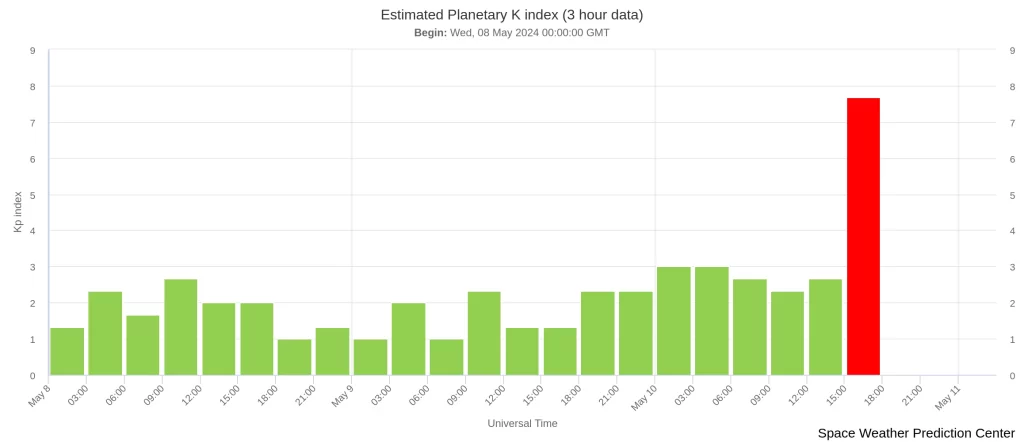
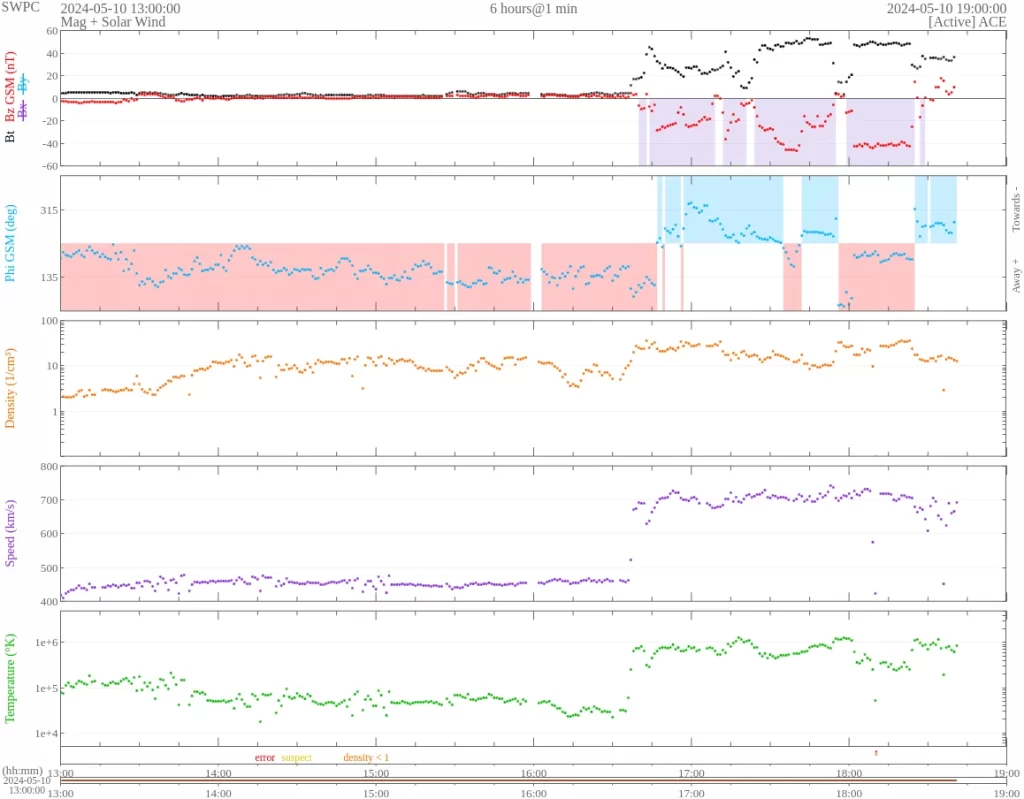
Proton flux started rising after 07:00 UTC on May 9 due to increased flare activity from Region 3664 and reached the S1 – Minor solar radiation storm threshold at 13:55 UTC on May 10.
As activity in this region continued, with numerous M- and several X-class flares, proton flux levels kept rising and reached S2 – Moderate levels at 17:46 UTC.
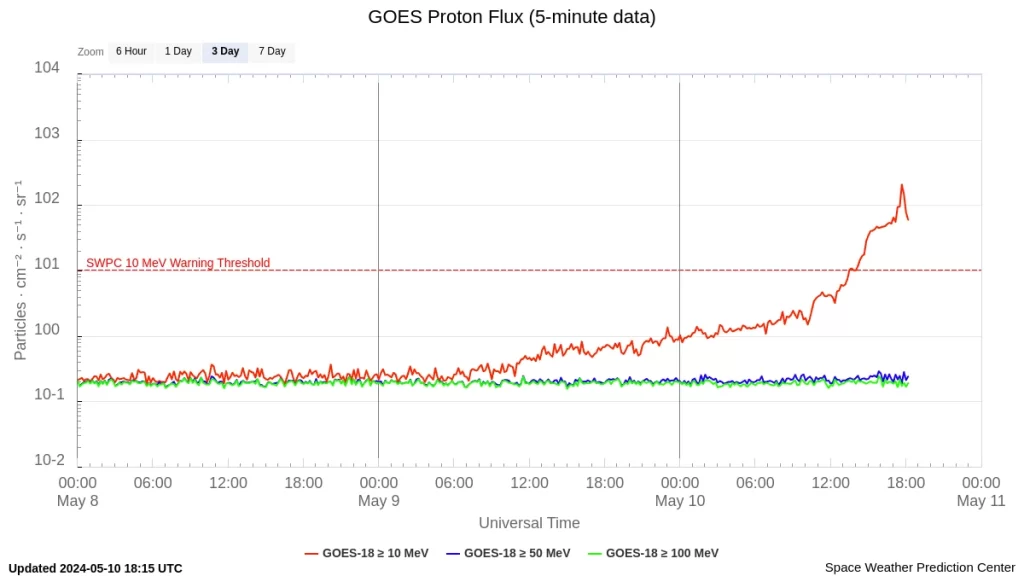
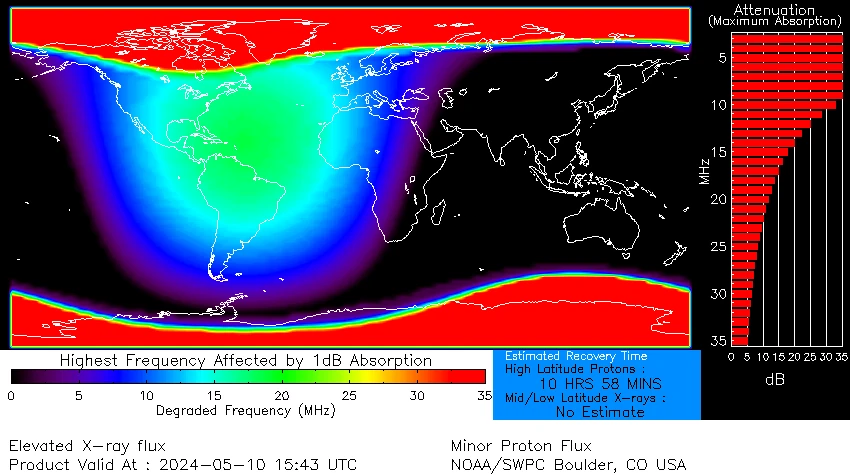
04:14 UTC, May 11
G5 – Extreme geomagnetic storm threshold was reached at 23:34 UTC.
Under G5 conditions, the area of impact is primarily poleward of 40 degrees Geomagnetic Latitude.
Widespread voltage control and protective system issues can occur in power systems, with some grid networks possibly facing complete collapse or blackouts. Transformers may suffer damage due to electrical stress.
Spacecraft operations may encounter significant surface charging, leading to problems with orientation, uplink/downlink communication, and satellite tracking.
In other systems, pipeline currents can surge to hundreds of amps, potentially causing infrastructure damage. High-frequency (HF) radio propagation might become impossible in many regions for up to two days, while satellite navigation could face degradation for several days. Low-frequency radio navigation may also be disrupted for hours. Auroras might be visible as far south as Florida and southern Texas, around 40° geomagnetic latitude.
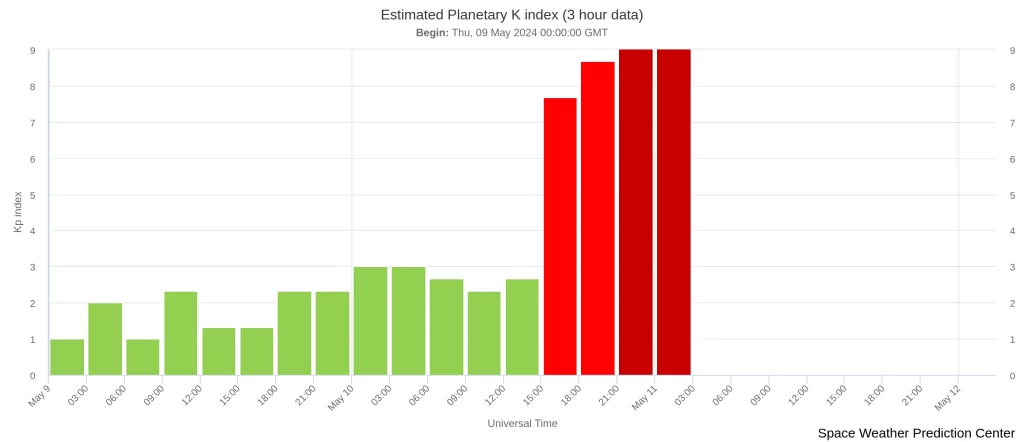
Periods of G3 – Strong to G5 – Severe geomagnetic storms are expected on May 11 due to continued CME activity.
References:
1 Forecast Discussion – Issued: 2024 May 09 1230 UTC – Prepared by the U.S. Dept. of Commerce, NOAA, Space Weather Prediction Center
Featured image credit: NASA/ESA LASCO C3

Commenting rules and guidelines
We value the thoughts and opinions of our readers and welcome healthy discussions on our website. In order to maintain a respectful and positive community, we ask that all commenters follow these rules.